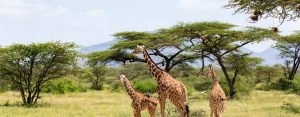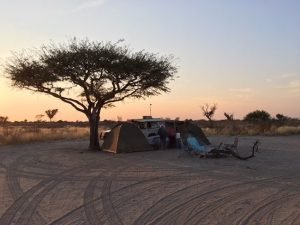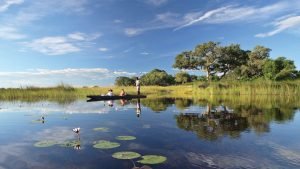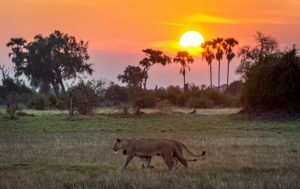
Kgalagadi Transfrontier Park
History was made when Botswana and a newly liberated, democratic South Africa signed in 1999 a treaty to form the first trans frontier peace park in Africa.
Plans to formalise the joint management and development of South Africa’s Kalahari Gemsbok National Park and Botswana’s Gemsbok National Park were proposed as early as 1989, but no such partnership was possible during South Africa’s dark years of apartheid. Following South africa’s independence in 1994, and with the support and encouragement of the Peace Parks Foundation, negotiations concretised; and in May 2002, the park was officially opened.
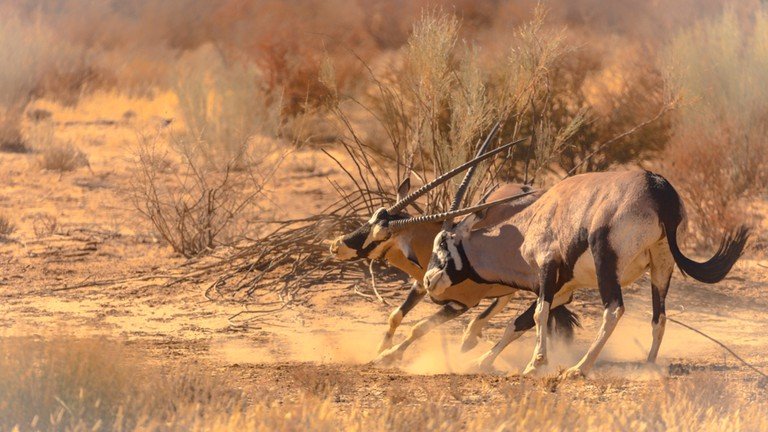
This immense wilderness (37 000 sq kms) is now shared by both countries as a protected area, and is jointly managed. The entire park is completely unfenced, allowing for wildlife to move freely along the ancient migration routes so necessary for their survival in the desert.
Situated in the extreme southwest corner of Botswana, and adjacent to South Africa’s Northern Cape Province, the Kgalagadi Transfrontier park (KTP) is run as a single ecological unit, and gate receipts are shared. Tourist facilities, however, are still run autonomously.

Immigration and customs facilities have been designed to allow travellers to enter the park in one country and depart in the other. The main entry and departure point between the two countries is at the Two Rivers/ Twee Rivieren gate, which also has camping facilities, chalets, shops and a restaurant.
The national boundary with South Africa is along the dry Nossop River bed; and three quarters of the park lies within Botswana territory. Currently, KTP is mainly visited by self-drive campers, with a few operators offering mobile tours.
At the time of going to print, the Botswana government had allocated five fixed lodge sites for development by the private sector.
There are three main areas to explore: the Nossop River valley, along the South Africa/Botswana border, the wilderness trails on the Botswana side, and what was once the Mabuasehube Game Reserve, now incorporated into KTP at its most northeastern reaches.
To maintain KTP’s pure wilderness experience, there are strict limits as to the number of vehicles that can travel the wilderness trails, how many nights a camping party can stay at a campsite (usually limited to one night), and how many people can camp at each campsite. Hence booking well in advance is essential.
Self-drive campers must comprise at least two vehicles; well-equipped 4x4s are required for the rough, sandy roads.
KTP’s very beautiful terrain comprises fossil river valleys dotted with dwarfed trees and bushes, grasslands and different coloured sand dunes. Wildlife is abundant, and the animals are attracted to waterholes along the otherwise dry riverbed.
Several species of antelope, including the ubiquitous springbok and gemsbok, hartebeest, and eland can be seen, as well as the famous black-maned Kalahari lion, jackal, brown hyena, and wild cats.

Rich birding is always part of the experience. Over 170 species of birds have been recorded here, and it is not uncommon to see over 30 bird species within a few kilometres of the campsite.
At Mabuasehube, the terrain is a mixture of typical Kgalagadi tree and shrub savanna with patches of wide open grass savanna.
This area of KTP comprises a series of exceptionally large pans, which are the principle focus of the reserve. Campsites dot the various pans, and many are situated on slight promontories, giving almost unimpeded vision, thus making for good game viewing right from your camp-side chair.
Three of the largest pans lie along the main road; these are Bosobogolo, Mpayathutlwa and Mabuasehube. others, like Leshologago, Khiding and the fossil valley complex called Monamodi, are linked to the larger pans by sand tracks.
Each pan is different. The floor of Mabuasehube pan is bare clay that is rich in salts, and this attracts animals that come to lick the surface, deriving essential minerals from it. The floor of Bosobogolo pan is short, shrubby grassland, which antelope frequent to graze, accompanied, of course, by predators.
All of the major predators can be seen at Mabuasehube, including the Kalahari black-maned lion, cheetah, leopard, brown hyena, bat-eared fox, lynx, and silver fox. Small mammals, like the Cape fox, aardwolf and blackfooted cat can be seen at the pans in the evening.
